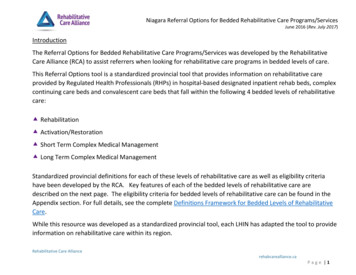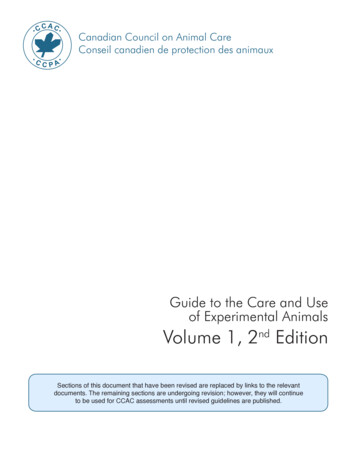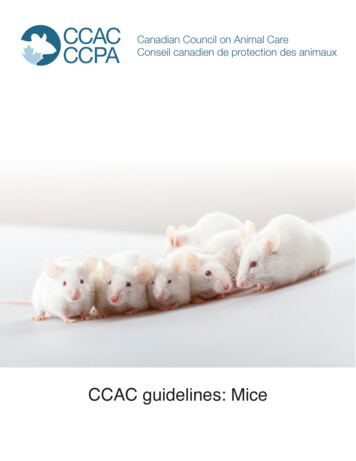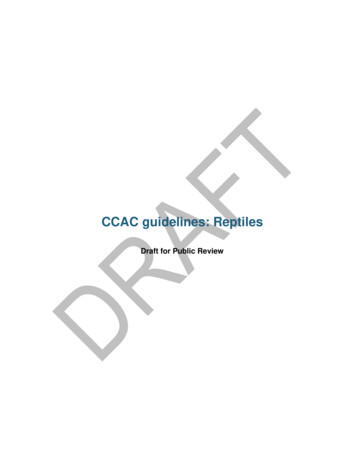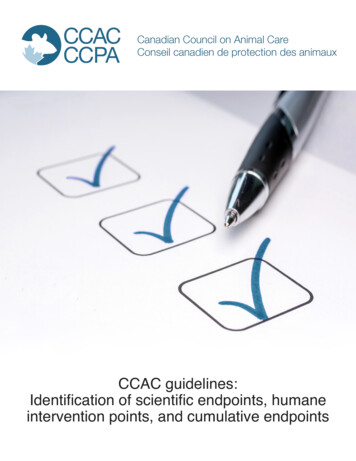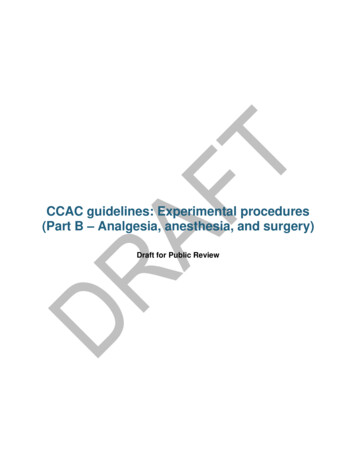
Transcription
CCAC guidelines: Experimental procedures(Part B – Analgesia, anesthesia, and surgery)Draft for Public Review
CCAC guidelines: Experimental procedures(Part B – Analgesia, anesthesia, and surgery)Draft for Public Review – April 2022TABLE OF CONTENTSPREFACE . 1LIST OF GUIDELINES . 21.INTRODUCTION – ANIMAL PAIN . 41.1Pain and Nociception . 41.2Modulators of Pain . 41.3Types of Pain . 51.4Recognizing and Treating Pain . 61.5Consequences of Unmitigated Pain on Scientific Outcomes . 72.ANALGESIA . 82.1Decision-Making Process . 82.1.1 Withholding Analgesia . 92.1.2 Analgesia Decision-Making Tree . 102.2Considerations When Selecting Analgesics . 112.3Types of Analgesics . 122.3.1 Non-Steroidal Anti-Inflammatory Drugs (NSAIDs) . 122.3.2 Opioids . 142.3.3 Local Anesthetics . 152.3.4 N-Methyl-D-Aspartate (NMDA) Receptor Antagonists . 162.3.5 Alpha-2-Adrenoceptor Agonists. 162.3.6 Gabapentinoids . 172.4Non-Pharmacological Analgesia . 182.4.1 Environment Modifications. 182.4.2 Additional Care . 182.4.3 Physiotherapy and Rehabilitation . 192.5Future Considerations. 213.ANESTHESIA . 223.1Pre-Anesthesia Preparation. 223.1.1 Animal Training . 223.1.2 Animal Assessment . 233.1.3 Fasting. 233.1.4 Antiemetics. 243.1.5 Anticholinergics . 243.2Tranquilizers and Sedatives . 253.2.1 Phenothiazines (e.g., Acepromazine) . 253.2.2 Butyrophenones (e.g., Azaperone) . 253.2.3 Benzodiazepines (e.g., Diazepam, Midazolam) . 263.2.4 Alpha-2-Adrenergic Agonists (e.g., (Dex)medetomidine, Xylazine) . 263.3Chemical Agents for Wildlife Capture and Transport . 263.3.1 Telazol . 263.3.2 Butorphanol-Azaperone-Medetomidine. 26
CCAC guidelines: Experimental procedures(Part B – Analgesia, anesthesia, and surgery)Draft for Public Review – April 20223.43.53.63.73.83.93.104.3.3.3 Ultra-Potent Opioid Agonists . 273.3.4 Long-Acting Neuroleptics. 27Anesthetic Methods and Agents . 273.4.1 Recommended Methods of Anesthesia . 283.4.2 Not Recommended, but Permissible Methods of Anesthesia. 293.4.3 Prohibited Methods of Anesthesia . 31Required Equipment for Inhalant Anesthesia . 32Stages of Anesthesia . 33Fluid Therapy . 33Animal Monitoring . 343.8.1 Monitoring Techniques . 34Emergency Support . 39Recovery Considerations. 39SURGERY . 414.1Facilities and Surgical Area . 414.2Equipment Sterilization . 424.2.1 Steam Autoclaving . 434.2.2 Gas Sterilization . 434.2.3 Gamma Irradiation . 434.2.4 Glass Bead Sterilization or Dry Heat Sterilization . 434.2.5 Cold Sterilization . 434.2.6 Post-Sterilization Equipment Storage. 444.3Pre-Operative Preparation . 444.4Surgical Site Preparation . 454.5Surgical Technique . 464.6Multiple Surgeries in a Single Session . 474.7Surgery on Immunocompromised Animals . 474.8Intra-Operative Monitoring and Nursing Care . 474.9Suturing . 484.10 Record Keeping . 494.11 Post-Surgical Recovery . 49REFERENCES . 51ii
CCAC guidelines: Experimental procedures(Part B – Analgesia, anesthesia, and surgery)Draft for Public Review – April 20221PREFACE234The Canadian Council on Animal Care (CCAC) is the national peer-review organizationresponsible for setting, maintaining, and overseeing the implementation of high standards ofethical care and use of animals in science throughout Canada.567891011The CCAC guidelines: Experimental procedures (Part B – Analgesia, anesthesia, and surgery) ispart of a series of general guidelines documents that outline principles for the ethical care anduse of all animals in science. This series streamlines information for investigators, studydirectors, instructors, animal care committees, facility managers, veterinarians, and animal carepersonnel to help facilitate improvement in both the care given to animals and how experimentalprocedures are carried out. More specific information on these experimental procedures can befound in the CCAC guidelines developed for specific types of animals.121314This guidelines document applies to all animals used for scientific purposes, including wildlifebrought into laboratory animal facilities and third-party-owned animals that are used off-site(e.g., at commercial farms or shelters).151617These guidelines describe current standards and processes for administering analgesia andanesthesia, and for surgery. The individual guideline statements in the document have beendeveloped based on expert peer advice and current interpretation of scientific evidence.18192021CCAC guidelines are intended to provide a framework for implementing Russell and Burch’sThree Rs: Replacement, Reduction, and Refinement (Russell and Burch, 1959), primarily theprinciple of Refinement. These practices are constantly evolving, and refinements should resultin continual improvement in animal welfare.222324For studies outside of Canada, investigators based at CCAC-certified institutions are subject tothese guidelines and the relevant legislation and regulations pertaining to ethical animal care anduse in the country where the study is conducted.1
CCAC guidelines: Experimental procedures(Part B – Analgesia, anesthesia, and surgery)Draft for Public Review – April 2022LIST OF GUIDELINES25262. Analgesia2728293031Guideline 1Appropriate analgesia should be provided for painful, or potentially painful, procedures.Analgesia must only be withheld if there is definitive evidence that all available options willcompromise the integrity of the scientific activity. In rare cases when analgesia is withheld, theremust be increased oversight over the protocol.32333435Guideline 2Appropriate analgesia should be selected through a collaborative process between protocolauthors and veterinarians.Section 2.1 Decision-Making Process36373839Guideline 3Persons responsible for monitoring animal pain, including the effectiveness of the analgesia,must be trained and deemed competent in this regard.Section 2.1 Decision-Making Process403. Anesthesia41424344Guideline 4Appropriate anesthesia, individualized to each animal and procedure, must be provided for eachprocedure warranting anesthesia. The anesthetic approach must be based on the expected welfareimpact that will be experienced by the animal, rather than solely on the procedure.45464748Guideline 5Supplemental oxygen should be provided during anesthesia, and whenever possible, the animalshould be intubated. Maintaining intravenous access is a best practice.Section 3.4 Anesthetic Methods and Agents49505152535455Guideline 6When using inhalant anesthesia, the vaporizer must be calibrated and its correct function must beverified, the anesthesia machine must be well maintained, and leak tests must be performedbefore each use. A fully functional scavenging system must be in place. Personnel must bedeemed competent to use the device before using the anesthesia machine and associatedequipment.Section 3.5 Required Equipment for Inhalant Anesthesia565758Guideline 7Monitoring must start in the pre-anesthesia phase and be regularly maintained until full recovery.Section 3.8 Animal Monitoring2
CCAC guidelines: Experimental procedures(Part B – Analgesia, anesthesia, and surgery)Draft for Public Review – April 2022596061Guideline 8Adequate care must be provided to all animals during the recovery period.Section 3.10 Recovery Considerations624. Surgery636465Guideline 9Aseptic technique must be maintained during all aspects of a recovery surgical procedure.Aseptic technique is strongly encouraged for non-recovery procedures.666768Guideline 10Surgical procedures must only be completed by someone who has been deemed competent toperform the procedure, or by someone being directly supervised by such a person.69707172Guideline 11Appropriate analgesia must be provided as part of post-operative care; this includes nonpharmacological and pharmacological options.Section 4.11 Post-Surgical Recovery3
CCAC guidelines: Experimental procedures(Part B – Analgesia, anesthesia, and surgery)Draft for Public Review – April 20221.73INTRODUCTION – ANIMAL PAIN747576Throughout this document, the term ‘should’ is used to indicate an obligation, for whichany exceptions must be justified to, and approved by, an animal care committee. The term‘must’ is used for mandatory requirements.771.178798081828384858687Congruent with the definition of pain in humans, this document uses the definition of animalpain formulated by the International Association on the Study of Pain: “an unpleasant sensoryand emotional experience associated with, or resembling that associated with, actual or potentialtissue damage” (IASP, 2017; Raja et al., 2020). Thus, pain is fundamentally a subjectiveexperience of each animal. Pain differs from nociception, which refers exclusively to the neuralprocess of encoding noxious stimuli (IASP, 2017; Raja et al., 2020) and does not imply anysentient processes. Generally, however, nociception underlies pain in conscious animals. Thismay not be true in appropriately anesthetized animals, when afferent neurons are surgicallysevered, preventing sensory information from reaching the central nervous system, or whencertain internal organs are damaged or removed, but these instances are exceptions, not the rule.88899091929394Animal pain is generally inferred based on behavioural or physiological indicators (e.g., via afacial grimace scale (Sotocinal et al., 2011), lameness evaluation (Shearer et al., 2013), and bymeasuring cytokines (Miller et al., 2014); see also Section 1.4, “Recognizing and TreatingPain”). The inability of an animal to express pain-related indicators (e.g., due to paralytics), orthe inability for humans to detect pain-related indicators (e.g., due to a lack of knowledge ortechnology on their part), does not necessarily mean that an animal is not experiencing pain(Raja et al., 2020).9596979899100Following the precautionary principle and extensive scientific literature across species, allanimals under the CCAC mandate (namely, nonhuman vertebrates or cephalopods; seeRequirement for Submitting an Animal Protocol – Addendum to the CCAC policy statement onterms of reference for animal care committees (CCAC, 2020)) are assumed to have thecapacity to feel pain. Thus, protocol authors must maximize refinements in scientific protocolsto minimize pain.1011.2102103104105106107108109110Pain has three main determinants: sensory or discriminative, motivational or affective, andcognitive or central control (Melzack and Casey, 1968). This means that the subjectiveexperience of pain is not solely dependent upon the specific injury or disease, but can be alteredby the individual’s affective and cognitive states. For example, environmental enrichment, awidely regarded method to improve affective states in animals, also reduces pain-relatedbehaviours when compared to similarly impaired animals housed without enrichment (e.g.,Vachon et al., 2013; Parent-Vachon and Vachon, 2018; Wang et al., 2019). Some examples ofenrichments that may help reduce pain-related behaviour include access to exercise, increasedenvironmental complexity, and access to preferred resources, including social partners (e.g.,Pain and NociceptionModulators of Pain4
CCAC guidelines: Experimental procedures(Part B – Analgesia, anesthesia, and surgery)Draft for Public Review – April 2022111112Vachon et al., 2013; Pham et al., 2010). Similarly, pain and depression-like behaviour in animalsare highly correlated and may have a reciprocal causative relationship (Li, 2015).113114115116117118119120121122123In the same way, many cognitive activities or psychosocial factors can lessen or increase theexperience of pain. For example, shifting attention away from painful stimuli can reduce painintensity and the expression of pain-related behaviours (e.g., Gentle, 2001), and in humans, evenperceived control over painful stimuli improves pain tolerance and the ability to cope withintractable pain (e.g., Salomons et al., 2004). A similar phenomenon has been seen in non-humananimals (e.g., Schaap et al., 2013). Furthermore, previous experience and prior conditioning ortraining can have either a negative or positive impact on the experience of pain, depending on thenature of the learned association (Miguez et al., 2014). Finally, there are well-established sexdifferences in pain perception and response to analgesics (Hurley and Adams, 2008), and thepresence of males may even produce stress-related analgesia in some animals (Sorge et al.,2014).124125126127Many different factors can modulate an animal’s experience of pain. This also means that thereare many avenues to lessen the impact of pain on animal welfare, in addition to the provision ofanalgesia, through measures such as environmental enrichment and positive 36137138139It is important to categorize different types of pain insofar as they may require differenttreatments or methods of evaluation (Backonja, 2003; see also Section 2, “Analgesia”). One ofthe main ways to differentiate types of pain is by the rapidity of onset and the timing of thecourse of clinical signs. Acute pain (considered to be physiological pain) is caused by a specificstimulus or injury, tends to last for a short duration (tied to the healing of the injury or removal ofthe stimulus), and is adaptive in that it generally motivates individuals to perform protectiveactions that promote recovery (Grichnik and Ferrante, 1991). Conversely, chronic pain(pathological pain) is not necessarily tied to a specific injury, lasts for extended periods, andgenerally does not have a protective function (Grichnik and Ferrante, 1991), though this may notbe true in all cases (e.g., Lister et al., 2020). Additionally, chronic pain often increases painsensitivity to other stimuli (e.g., Lee et al., 2010).140141142143144145Another potential distinction is between somatic and visceral pain – this distinction is based onwhere the pain sensation originates within the body. Somatic pain results from damage to nonvisceral tissue (e.g., skin, muscle, deep tissue) and is generally well-defined and easy to locate(Woolf, 1995). Visceral pain, however, originates from internal organs, typically resulting fromstretching, ischemia, or inflammation, and can be hard to locate as the sensation is often diffuse(Cervero and Laird, 1999).146147148149150151Within the two broader categories of somatic and visceral, there are additional types of pain. Thethree main types considered here are nociceptive, neuropathic, and inflammatory. Nociceptivepain describes either somatic or visceral pain processed by a normal, unaltered nervous systemthat arises from damage to non-neural tissue (Mogil, 2009; IASP, 2017). This type of pain isoften acute and commonly results from noxious stimuli such as heat or cuts, but it can alsocontribute to chronic pain.Types of Pain5
CCAC guidelines: Experimental procedures(Part B – Analgesia, anesthesia, and surgery)Draft for Public Review – April 2022152153154155Neuropathic pain is caused by a lesion or disease of the somatosensory nervous system (IASP,2017). This type of pain is often chronic, with pain and sensory symptoms persisting beyond thehealing period (Backonja, 2003). Neuropathic pain is often connected to disease states such ascancer and diabetes, or results from direct damage to a nerve.156157158159160Inflammatory pain is typically characterized by allodynia and hyperalgesia that occur in responseto tissue damage and associated inflammation (Polston and Wallace, 2017). Post-operative pain,which is a specific form of acute pain caused by surgical trauma, falls within this category(Gupta et al., 2010). For expectations regarding monitoring and treating post-surgical pain, seeSection 4.11, “Post-Surgical Recovery”.161162163164165More recently, a fourth type of pain has been characterized: nociplastic pain. This type of pain“arises from altered nociception despite no clear evidence of actual or threatened tissue damagecausing activation of peripheral nociceptors or evidence for disease or lesion of thesomatosensory system causing the pain” (IASP, 2017). This is an emerging area of work, and itsimplications on animal welfare are currently 179180181182183184185One of the main methods used to assess animal pain is through the evaluation of behaviouralchanges. In general, animals experiencing pain eat less, spend less time grooming, are lessactive, and may become more aggressive (e.g., Mellor et al., 2000; Mayer, 2007). It is importantthat those assessing the behaviour of the animals are familiar with species-typical behaviour, andwhere possible, each animal’s baseline behaviour, as pain should be assessed based on changesfrom this baseline. For some species, there are well-characterized behavioural responses to acutepain (e.g., dogs and cats (Mathews et al., 2014; Epstein et al., 2015); rodents (Deuis et al.,2017)), but for many animals, there is a lack of specific validated behavioural signs of pain(Viñuela-Fernández et al., 2007). As a general guiding principle, pain can be recognized as itelicits protective reactions, results in learned behaviour, and possibly modifies species-specificbehaviour (Zimmerman, 1986). However, not all pain results in readily observable behaviouralchanges, and some animals may hide their pain in the presence of predators (in this case,humans) or conspecifics to mask their vulnerability (Anil et al., 2002). One option to address thisissue is to video record the animal’s behaviour so that it can be assessed remotely without anyobserver effects on the behaviour. Additional guidance on recognizing and monitoring pain canbe found in CCAC animal-type guidelines, the CCAC guidelines: Husbandry of animals inscience (CCAC, 2017), the CCAC guidelines: Animal welfare assessment (CCAC, 2021), and theCCAC guidelines on identifying scientific endpoints, humane intervention points, andcumulative endpoints (in prep.).186187188189190191192193There are also some physiological correlates of pain (particularly acute pain) stemming fromactivation of the sympathetic nervous system and hypothalamic-pituitary-adrenal axis; theseinclude increased blood pressure or heart rate and higher levels of circulating ‘stress hormones’such as epinephrine and cortisol or corticosterone (Chawla and Kochar, 1999). These indicatorsmay be used in conjunction with behavioural indicators; however, they should not be used as theprimary method of pain assessment for three main reasons: 1) these responses are moreindicative of nociception rather than pain as they still occur in anesthetized and decerebrateanimals (e.g., Sivarao et al., 2007); 2) they are not specific to pain, but rather indicate generalRecognizing and Treating Pain6
CCAC guidelines: Experimental procedures(Part B – Analgesia, anesthesia, and surgery)Draft for Public Review – April 2022194195arousal levels; and 3) they are harder to assess practically, and the assessment itself may have anegative welfare impact on the animals.196197198199200201202203204205In terms of practically managing animal pain, any protocol that involves a potentially painfulprocedure must describe how this pain will be alleviated. If an animal is going to experiencetissue damage, this should always be considered painful. Similarly, if an animal is going toexperience something that would be considered painful for a human, this should also beconsidered painful to the animal. The precautionary principle must always be applied tocases of potential animal pain. If there is uncertainty around whether an animal will experiencepain, treatment must be provided. Pain relief must be provided unless the protocol author candefinitively demonstrate that the treatment will compromise the integrity of the data. When painrelief is provided, it is imperative that animal pain be adequately monitored to ensure the efficacyand safety of the 18219Pain affects physiological and behavioural outcomes, creating potential confounds within manytypes of studies (AALAS, 2019). For example, post-surgical pain (along with recovery fromanesthesia) can result in post-operative complications such as impaired respiratory function,decreased gut motility and urinary retention, long-term changes in the central nervous system,sleep impairments, and infections (Kona-Boun et al., 2005; Richardson and Flecknell, 2005).Pain can also impair wound healing and cause dysregulation of several hormones,neurotransmitters, and enzymes (Jirkof, 2017). Immunity can be compromised by pain (Baral etal., 2019), not just peripherally, but within the brain as well, which has an additional effect onpain-associated affective disorders (Barcelon et al., 2019). Another consideration is that pain canbe socially modulated, potentially resulting in hyperalgesia or increased anxiety in cage mates ofanimals experiencing pain (e.g., Langford et al., 2006; Baptista-de-Souza et al., 2015; Smith etal., 2016). There are also concerns about the translatability and reproducibility of rodent studiesthat do not employ pain mitigation (e.g., Peterson et al., 2017).220221222223224225226227228229Untreated pain can have a serious effect on scientific outcomes and should thus be controlled aspart of good experimental design (Richardson and Flecknell, 2005). In some cases, however,certain types of analgesia may be known to interfere with scientific objectives. If this is the case,the first step must be to consider alternative types of analgesia (e.g., Lilley et al., 2015). The nextstep should be to acknowledge and compare the scientific impacts of analgesia provision versusuntreated pain, possibly using a pilot study. Only in cases where providing pain relief wouldirrevocably corrupt the data, where no alternatives exist, and where the research is deemed to beof significant enough value should pain relief be withheld. If pain relief is withheld, theseprotocols must receive increased oversight, including rigorous humane intervention pointmonitoring (see Section 2.1, “Decision-Making Process”).Consequences of Unmitigated Pain on Scientific Outcomes7
CCAC guidelines: Experimental procedures(Part B – Analgesia, anesthesia, and surgery)Draft for Public Review – April 20222.230ANALGESIA231232233234235Guideline 1Appropriate analgesia should be provided for painful, or potentially painful, procedures.Analgesia must only be withheld if there is definitive evidence that all available options willcompromise the integrity of the scientific activity. In rare cases when analgesia is withheld,there must be increased oversight over the protocol.2362.1237238This section describes principles and practices that should guide decision-making around the useof analgesia.239240241Guideline 2Appropriate analgesia should be selected through a collaborative process between protocolauthors and titutions are encouraged to create high-level standard operating procedures (SOPs) thatdescribe pain management practices related to scientific procedures. These SOPs should betailored to the species of animal, the expected severities (e.g., mild, moderate, and severe) anddurations (e.g., short, medium, long) of pain, and should form the basis for a sharedunderstanding of pain management expectations among all stakeholders. Thus, these SOPsshould describe pain management principles and steps to limit negative animal welfare impacts.The SOPs could then be adapted by protocol authors, following veterinary consultation whereappropriate (see below). Using SOPs in this manner should help standardize pain managementand promote transparency while minimizing the burden on animal care committees to create andmaintain SOPs for many different situations. Alternatively, procedure-specific pain managementpractices may be described within procedural SOPs at the animal care committee’s 266267The most important principle is that all decisions regarding the use of analgesia are made in acollaborative process between everyone involved in the scientific activity and animal care.
CCAC guidelines: Experimental procedures (Part B - Analgesia, anesthesia, and surgery) Draft for Public Review - April 2022 1 1 PREFACE 2 The Canadian Council on Animal Care (CCAC) is the national peer-review organization 3 responsible for setting, maintaining, and overseeing the implementation of high standards of




